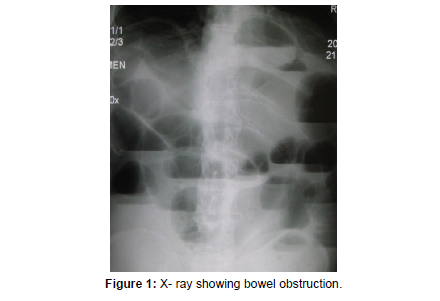Understanding Bowel Obstruction: Causes, Symptoms and Treatment
Received: 03-Jun-2023 / Manuscript No. roa-23-103630 / Editor assigned: 05-Jun-2023 / PreQC No. roa-23-103630 (PQ) / Reviewed: 19-Jun-2023 / QC No. roa-23-103630 / Revised: 22-Jun-2023 / Manuscript No. roa-23-103630 (R) / Published Date: 29-Jun-2023 DOI: 10.4172/2167-7964.1000458
Image Article
Bowel obstruction also known as intestinal obstruction is a medical condition characterized by a partial or complete blockage of the intestines, preventing the normal passage of food, fluids, and gas. It can occur in any part of the digestive tract, including the small intestine or large intestine. Bowel obstructions require prompt medical attention, as they can lead to serious complications if left untreated. This article aims to provide an overview of bowel obstruction, including its causes, symptoms and available treatment options [1].
Causes of bowel obstruction
Adhesions: Adhesions are bands of scar tissue that can form after abdominal surgery or inflammation, such as from Crohn’s disease or endometriosis. These bands can cause the intestines to stick together, leading to obstruction.
Hernias: A hernia occurs when an organ or tissue protrudes through a weak spot in the abdominal muscles. If a part of the intestine becomes trapped in the hernia, it can cause a blockage.
Tumors: Both benign and malignant tumors can obstruct the bowel by physically blocking the passage of stool or compressing the intestines from the outside.
Intussusception: This occurs when a section of the intestine folds in on itself, much like a telescope, leading to obstruction. It is more common in infants and children.
Volvulus: Volvulus is a condition in which the intestine twists on itself, causing a blockage. It is often seen in the large intestine and is more prevalent among older adults.
Symptoms of bowel obstruction
Abdominal pain and cramping: This pain is typically severe and may be accompanied by bloating and distension.
Constipation or inability to pass gas: The blockage prevents the normal passage of stool and gas, leading to constipation and abdominal discomfort [2].
Nausea and vomiting: As the obstruction worsens, the body may attempt to expel the contents of the stomach, resulting in nausea and vomiting.
Swelling and tenderness: The abdomen may become swollen and tender to the touch.
Inability to tolerate food: Due to the obstruction, patients may experience a loss of appetite and an aversion to eating.
Treatment options
The treatment for bowel obstruction depends on the severity of the condition and its underlying cause. In some cases, non-surgical interventions may be effective, while others may require surgical intervention [3]. Treatment options include:
Non-surgical interventions: These include nasogastric decompression, where a tube is inserted through the nose into the stomach to remove fluid and relieve pressure. Medications may also be administered to reduce pain and inflammation (Figure 1).
Surgery: In cases of complete obstruction or when non-surgical interventions fail, surgical intervention is necessary. The type of surgery performed will depend on the cause of the obstruction and may involve removing the blockage, repairing hernias, or resecting a portion of the intestine.
Supportive care: Patients with bowel obstruction often require intravenous fluids to prevent dehydration and electrolyte imbalances. Pain management and close monitoring of vital signs are also essential.
Conclusion
Bowel obstruction is a serious medical condition that requires timely diagnosis and treatment. Understanding the causes, symptoms, and treatment options can help individuals recognize the signs and seek appropriate medical care. If you experience persistent abdominal pain, bloating, or changes in bowel movements, it is important to consult a healthcare professional.
Acknowledgement
None
Conflict of Interest
None
References
- Lee EH, Yang HR (2020) Nationwide Population-Based Epidemiologic Study on Childhood Intussusception in South Korea: Emphasis on Treatment and Outcomes. Pediatr Gastroenterol Hepatol Nutr 23: 329-345.
- Panzera F, Di Venere B, Rizzi M, Biscaglia A, Praticò CA, et al. (2021) Bowel intussusception in adult: prevalence, diagnostic tools and therapy. World J Methodol 11: 81-87.
- Marinis A, Yiallourou A, Samanides L, Dafnios N, Anastasopoulos G, et al. (2009) Intussusception of the bowel in adults: a review. World J Gastroenterol. 15: 407-411.
Indexed at, Google Scholar, Crossref
Indexed at, Google Scholar, Crossref
Citation: Albert P (2023) Understanding Bowel Obstruction: Causes, Symptoms and Treatment. OMICS J Radiol 12: 458. DOI: 10.4172/2167-7964.1000458
Copyright: © 2023 Albert P. This is an open-access article distributed under the terms of the Creative Commons Attribution License, which permits unrestricted use, distribution, and reproduction in any medium, provided the original author and source are credited.
Share This Article
Open Access Journals
Article Tools
Article Usage
- Total views: 1072
- [From(publication date): 0-2023 - Mar 29, 2025]
- Breakdown by view type
- HTML page views: 867
- PDF downloads: 205

